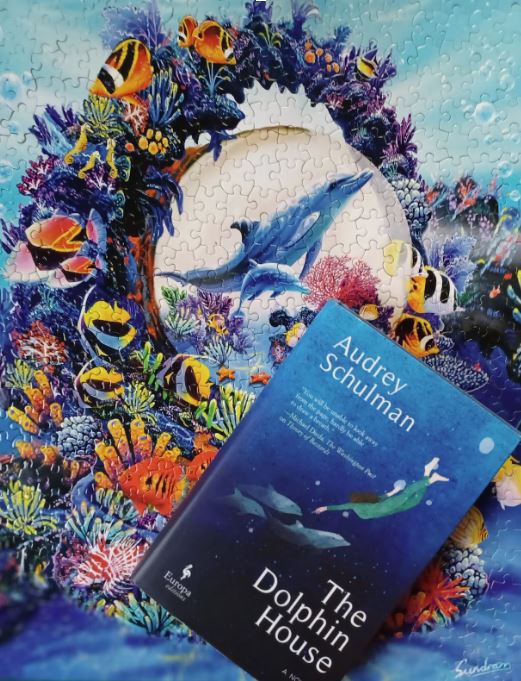by Nicole Yurcaba

In the 1960s, Margaret Lovatt participated in a NASA-funded project focused on communicating with dolphins. She lived 24 hours per day with a dolphin named Peter, a prepubescent dolphin, in a house called the Dolphinarium. While the purpose of Lovatt’s participation was to teach Peter words in English, the experiment veered into strange, sexual territory. Peter, in prepubescent dolphin fashion, required some sexual relief. While the study made rather significant contributions to human-animal communication research, the scandal surrounding Lovatt’s “relations” with Peter, as well as the project manager’s interest in LSD, threatened the project. If this sounds like a recipe for a good novel, well, it is. Audrey Schulman’s The Dolphin House (Europa Editions, 2022) fictionalizes Lovatt’s story, and it’s more than just a human-animal erotic story.
Similarly to novels like Katy Simpson Smith’s The Weeds, The Dolphin House focuses on female roles in the sciences and how historical male dominance in these fields has overshadowed women’s contributions. Cora, the novel’s main character based on Lovatt, possesses a passion for and intuition for working with animals. However, she lacks any formal scientific training or education. She trains the dolphins at Blum’s research facility, and she eventually resides with the dolphin Junior in a “homearium.” Throughout the novel, the jealousy from Cora’s research colleagues Eh, Tibbet, and Blum are quite evident. Eh and Tibbet do not take her contributions seriously because of her lack of training. Blum, the research project’s head, does take Cora’s contributions seriously, but beneath Blum’s academic interests lie sexual tensions and his own greed for academic respect, admiration, and affirmation. Cora’s experience in the sciences is, sadly, not so uncommon even in contemporary academia which touts more accessibility, equity, diversity, and inclusion. Thus, Blum serves as a prime example of The Matilda Effect–the bias of acknowledging the achievement of women scientists whose work is attributed to their male colleagues.
The Dolphin House also features another cringy aspect women face while working in the sciences and academia–overt sexualization by not only male colleagues, but the media. In the novel, as Cora’s progress with the dolphins continues, the media begins flocking to the research facility. At first, Blum takes credit for Cora’s research findings and the media attention centers on him. Eventually, however, the media attention shifts to Cora. Tibbet asserts, “‘The reporters come here because you look good in a bathing suit. The photos sell copies’” and “‘You are an animal trainer. You should work at Marine World. If you were a man, no reporters would come here at all.’” Tibbet’s sentiments echo an unfortunate sexualization of female scientists which has significantly impacted how society views and accepts women in STEM fields. Studies show that media responses toward female scientists and male scientists differ and that the process of sexualization harms female scientists more than it does male ones. In Schulman’s novel, Cora is the unfortunate victim of this, initially when media outlets begin snapping photos of her in her bathing suit, and then when a demeaning sketch of her having intercourse with a dolphin appears on the cover of a men’s magazine. Cora’s outcomes, sadly, directly mirror Howe’s. Hustler published an unfortunate article about the experiment–one that would taint the experiment and make Howe uncomfortable for years to come.
How much human-dolphin sex actually appears in the novel? Very little, actually. In fact, one of Cora’s struggles is how humans define sex. The act Cora performs on Junior is the same act Cora eventually performs on her veterinarian boyfriend–basically a handjob. According to online articles detailing Howe’s relationship with Peter, Howe states she wasn’t comfortable performing these acts on Peter, but doing so kept him focused on the experiment, so it was easier for Howe to relieve Peter manually. Mature readers will be able to focus on the in-the-name-of-science ideology in Cora’s actions, while immature ones will, well, giggle.
The Dolphin House is the type of novel one settles in with on a dreary night and doesn’t put down easily. Those interested in science and biology will find the original inspiration for the novel quite fascinating. Others might gravitate to the novel’s conversation about the ethics of animal testing. The more deviant will read the book and google the original Hustler article. However, Schulman’s book is a commentary on a time period whose attitudes toward women still influence contemporary society, and Cora is an unforgettable, sympathetic, original heroine whose experience blends historical fact and her own unique adventure.
Nicole Yurcaba (Ukrainian: Нікола Юрцаба–Nikola Yurtsaba) is a Ukrainian (Hutsul/Lemko) American poet and essayist. Her poems and essays have appeared in The Atlanta Review, The Lindenwood Review, Whiskey Island, Raven Chronicles, West Trade Review, Appalachian Heritage, North of Oxford, and many other online and print journals. Nicole teaches poetry workshops for Southern New Hampshire University and is a guest book reviewer for Sage Cigarettes, Tupelo Quarterly, Colorado Review, and The Southern Review of Books.


Add your first comment to this post